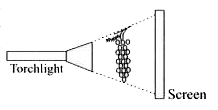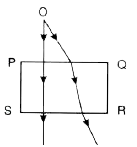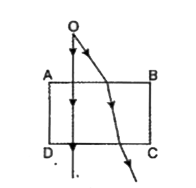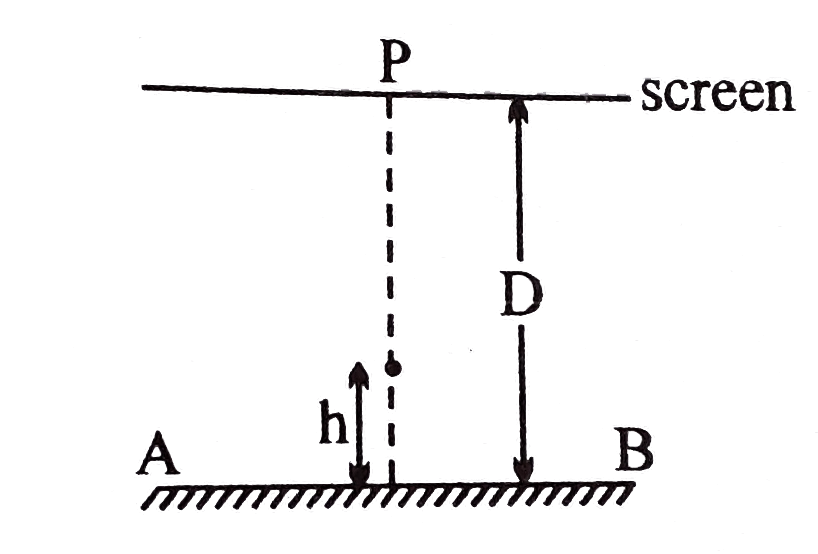Anu shone a torchlight at a bunch of grapes as shown here. What can Anu do to enlarge the shadow of the bunch of grapes on the screen?

(i) Shift the grapes nearer to the torchlight.
(ii) Shift the screen away from the grapes.
(iii) Shift the screen closer to the grapes.
(iv) Shift the torchlight further away from the grapes.
(i) and (iii) only
(i) and (ii) only
(iii) and (iv) only
(ii) and (iv) only
The correct Answer is:B
To increase the size of shadow either the distance between object and source of light should be decreased or the distance between object and screen should be increased.
Topper's Solved these Questions
- NSO QUESTION PAPER 2017- 18 SET - BBook:SCIENCE OLYMPIAD FOUNDATION Chapter:NSO QUESTION PAPER 2017- 18 SET - BExercise:ACHIEVERS SECTION
Explore 3 Videos
- NSO MODEL TEST PAPER 03Book:SCIENCE OLYMPIAD FOUNDATION Chapter:NSO MODEL TEST PAPER 03Exercise:ACHIEVERS SECTION
Explore 2 Videos
- NSO QUESTION PAPER 2017-18 SET ABook:SCIENCE OLYMPIAD FOUNDATION Chapter:NSO QUESTION PAPER 2017-18 SET AExercise:SCIENCE
Explore 10 Videos
Similar Questions
An object placed on a metre scale at 8 cm mark was focussed on a white screen placed at 92 cm mark, using a converging lens placed on the scale at 50 cm mark.
(i) Find the focal length of the converging lens.
(ii) Find the position of the image formed if the object is shifted towards the lens at a position of 29 cm.
(iii) State the nature of the image formed if the object is further shifted towards the lens.
View SolutionA student focussed the image of a candle flame on a white screen using a convex lens. He noted down the positive of the candle, screen and the lens as under.
Position of candle = 12.0 cm
Position of the screen = 50.0 cm
Position of the screen = 88.0 cm
(i) What is the focal length of the convex lens ?
(ii) Where will the image be formed if he shifts the candle towards the lens at a position of 31.0 cm ?
(iii) What will be the nature of the image formed if the further shifts the candle towards the lens ?
(iv) Draw a ray diagram to show the formation of the image in case (iii) as said above .
View SolutionA student focussed the image of a candle flame on a white screen using a convex lens. He noted down the position of the candle, screen and the lens as under
Position of candle =12.0cm
Position of convex lens =50.0cm
Position of the screen =88.0cm
(i) What is the focal length of the convex lens ?
(ii) Where will the image be formed if he shifts the candle towards the lens at a position of 31.0cm.
(iii) What will be the nature of the image formed if he further shifts the candle towards the lens ?
(iv) Draw a ray diagram to show the formation of the image in case (iii) as said above.
View SolutionA student focussed the image of a candle flame on a white screen using a convex lens. He noted down the position of the candle, screen and the lens as under
Position of candle =12.0cm
Position of convex lens =50.0cm
Position of the screen =88.0cm
(i) What is the focal length of the convex lens ?
(ii) Where will the image be formed if he shifts the candle towards the lens at a position of 31.0cm.
(iii) What will be the nature of the image formed if he further shifts the candle towards the lens ?
(iv) Draw a ray diagram to show the formation of the image in case (iii) as said above.
View SolutionA point source of light O of single colour is seen through a rectangular glass slab PQRS. The paths of two rays, in and outside the slab, are shown in figure.

In the diagram, label the position I of the source O where it will appear when seen through the surface RS.
(ii) Does the source O appear to be nearer or farther with respect to the surface PQ ?
(iii) How does the shift depend on the thickness PS or QR of the slab?
(iv) Justify your answer in (iii) with the help of an appropriate ray diagram.
(v) For the same rectangular glass slab, which colour from the visible spectra (violet to red) will produce the maximum shift ?
View SolutionA monochromatic point source of light O is seen through a rectangular glass block ABCD. Path of two rays in and outside the block are as shown in the figure below.
 .
.
(i) Does the source appear to be nearer or farther with respect to surface AB?
(ii) How does the shift depend upon the thickness AD or BC of the block ?
(iii) Justify your answer in (ii) with the help of ray diagram.
(iv) For the same rectangular block which colour from the visible spectra will produce the maximum shift ?
View SolutionA point sources S emitting light of wavelength 600nm is placed at a very small height h above the flat reflecting surface AB(see figure).The intensity of the reflected light is36% of the intensity.interference firnges are observed on a screen placed parallel to the reflecting surface a very large distance D from it.
(A)What is the shape of the interference fringes on the screen?

(B)Calculate the ratio of the minimum to the maximum to the maximum intensities in the interference fringes fromed near the point P (shown in the figure) (c) if the intenstities at point P corresponds to a maximum,calculate the minimum distance through which the reflecting surface AB should be shifted so that the intensity at P again becomes maximum.
View SolutionA point sources S emitting light of wavelength 600nm is placed at a very small height h above the flat reflecting surface AB(see figure).The intensity of the reflected light is36% of the intensity.interference firnges are observed on a screen placed parallel to the reflecting surface a very large distance D from it.
(A)What is the shape of the interference fringes on the screen?

(B)Calculate the ratio of the minimum to the maximum to the maximum intensities in the interference fringes fromed near the point P (shown in the figure) (c) if the intenstities at point P corresponds to a maximum,calculate the minimum distance through which the reflecting surface AB should be shifted so that the intensity at P again becomes maximum.
View SolutionRohit focused the image of a candle flame on a white screen using a convex lens. He noted down the position of the candle, screen and lens as under:
Position of candle = 26.0 cm
Position of convex lens = 50.0 cm
Position of screen=74.0 cm
(i) What is the focal length of the convex lens ?
(ii) Where will the image be formed if he shifts the candle towards the lens at a position of 38 cm ?
(iii) Draw a ray diagram to show the formation of the image in case (ii) as said above?
View SolutionA double slit interference pattern is produced on a screen, as shown in the figure, using momochromatic light of wavelength 500 nm. Point P is the location of the central bright fringe, that is produced when light waves arrive in phase without any path difference. A choice of the three strips A, B and C of transparent materials with different thickness and refractive indices is available, as shown in the table. These are placed over one or both of the slits, singularly or in conjunction causing the interference pattern to be shifted across the screen from the original pattern. In the Column - I, how the strips have been placed, is mentioned whereas in the Column-II, order of the fringe at point P on the screen that will be produced due to the placement of the strip(s), is shown. Correctly match both the column.

View Solution
